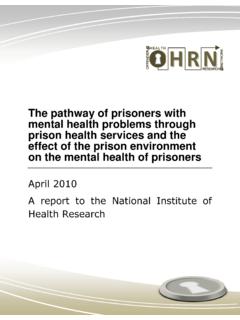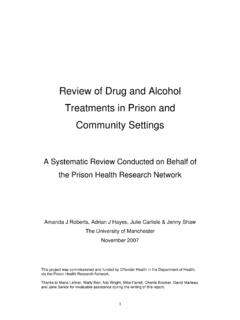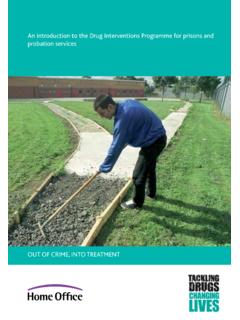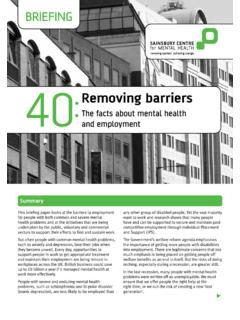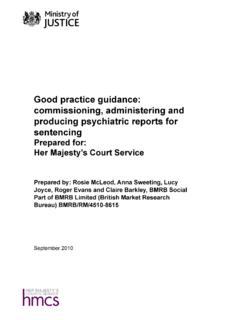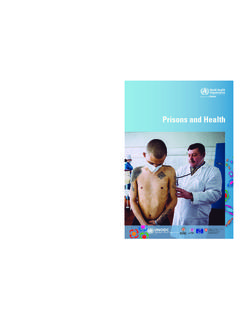Transcription of and the criminal justice system - Offender Health Research ...
1 BRIEFINGS ummary39:Mental Health care and the criminal justice systemThe population in custody has soared in the last decade and a significant proportion of those who end up in the criminal justice system have a mental Health problem. Responsibility for prison Health care lies with the NHS. It aims to give prisoners access to the same quality and range of Health services as the general public receives in the community. This is an enormous challenge. Many prisoners have a combination of mental Health problems, substance misuse and personality disorder, as well as a range of other issues to deal and a lack of staff skilled in identifying and managing mental Health problems are major problems that need to be addressed. There is growing evidence that prisons are not effective at reducing offending and that the costs, both financial and social, of containing people in prison without access to appropriate Health care are too resettlement experience of most prisoners is poor with most receiving little meaningful help on leaving prison.
2 It is vital that, upon leaving prison, people are well supported and linked in to community services and that support is available in the briefing paper examines the provision of mental Health care in the criminal justice system . It looks at what has been achieved to date and identifies priorities for further work. c2 Sainsbury Centre for Mental Health BRIEFING 39 Mental Health care and the criminal justice systemFigure 1: Mental Health problems in prisons and the general populationPrevalence among prisoners(16 years+)Prevalence in general population (16-64 years)Psychosis 8% disorder66% , anxiety etc45% dependency45% dependency30% : Singleton et al. (1998)Source: Singleton et al. (2000)Mental Health in prisonsEngland and Wales together have one of the highest rates of imprisonment in Western Europe. In May 2009, 82,900 people were in prison (MoJ, 2009a) and this is forecast to rise to over 100,000 by 2014 (Carter, 2007).
3 Up to 90% of prisoners have some form of mental Health problem (Singleton et al., 1998) and 10% of male and 30% of female prisoners have previously experienced a psychiatric acute admission to hospital (DH, 2007). Most prisoners with mental Health problems have common conditions, such as depression or anxiety. A smaller number have more severe conditions such as psychosis. Figure 1 shows the prevalence of mental Health problems in prisons compared to the general of self harm and attempted suicide in prison are high. A total of 61 prison suicides (MoJ, 2009b) and 23,026 self-harm incidents (House of Commons, 2009a) were recorded in 2008. Women represent 5% of the prison population, but account for over half of all reported self-harm incidents (HMIP, 2009). Not everyone enters prison with a mental Health problem: for some, being in prison will lead them to develop depression or anxiety (JCHR, 2004).Ethnicity People from Black and minority ethnic (BME) communities represent about 10% of the UK population (ONS, 2001) but in prison this rises to 26%, a significant proportion of whom are foreign nationals (MoJ, 2008).
4 There are high rates of suicide among foreign nationals: 25% of all prison suicides in 2007/8 (HMIP, 2009). Some Black communities are also over-represented in secure mental Health forensic hospitals (Rutherford & Duggan, 2007). While the rate of diagnosed mental Health problems in prison is lower in BME people than among the white population, this may reflect lower levels of identification and referral (Durcan & Knowles, 2006). WomenOf the 82,900 people in prison on 31 May 2009, 4,300 were females (MoJ, 2009a). A study of 500 women prisoners found that women in custody are five times more likely to have a mental Health concern than women in the general population (University of Oxford, cited in Prison Reform Trust, 2008). Women serve shorter sentences, but during that time their children may be taken into the care of the local authority, and they may lose both their job and their home, increasing the likelihood of re-offending and mental illness.
5 The Women s Offending Reduction Programme (Home Office, 2004) has acknowledged this and aims to reduce women s re-offending by ensuring that women receive greater support before, during and after custody. The Home Office-commissioned Corston Review recommended completely replacing the women s prison estate and creating better alternatives (Home Office, 2007).3 Sainsbury Centre for Mental Health BRIEFING 39 Mental Health care and the criminal justice systemYoung peopleAt the end of May 2009, there were 2,100 young people aged 15-17 years and 9,600 aged 18-21 years in custody (MoJ, 2009a). The majority are held in Young Offender people in custody have an even greater prevalence of poor mental Health , with 95% of 16 to 20 year olds having at least one mental Health problem and 80% having more than one (Lader et al., 2000). Few have any qualifications with up to three-quarters having experienced exclusion from school (Harrington & Bailey, 2005).
6 Many young people had traumatic experiences, such as bereavement, sexual abuse or violence in the home, prior to their incarceration. Young males are 18 times more likely to commit suicide in custody than in the community (Prison Reform Trust, 2007).Imprisonment for Public Protection (IPP)On 30 April 2009, there were 5,246 prisoners subject to the indeterminate sentence of Imprisonment for Public Protection (IPP). One hundred and four IPP prisoners were being detained in secure psychiatric hospitals (House of Commons, 2009b). IPP is an indeterminate sentence given to offenders who are identified by the courts as dangerous but whose offences do not carry a life sentence. The Government forecasts that the number of IPP prisoners will rise to 12,000 by 2014 (MoJ, 2007). Levels of mental illness and complex need are far higher among IPP prisoners than among the general prison population. Nearly one in five IPP prisoners has previously received mental Health treatment, while one in ten is receiving mental Health treatment in prison and one in five is on mental Health medication.
7 IPP prisoners must often complete a number of Offender Behaviour Programmes in order to be considered eligible for release. There is evidence that prisoners whom staff consider to be unsuitable to participate because of mental illness or emotional instability are often excluded from taking part in these programmes (Sainsbury Centre, 2008a).Unemployment and social exclusionPrisoners are disadvantaged in many ways before coming into contact with the criminal justice system : 67% were unemployed before going to prison (SEU, 2002); 70% will have no employment or placement in training / education on release (Niven & Stewart, 2005); 42% of released prisoners have no fixed abode (cited in Williamson, 2006); 65% of prisoners have numeracy skills at or below the level of an 11-year-old and 48% have reading skills at or below this level (SEU, 2002).It is estimated that being in work reduces the risk of re-offending by between a third and a half (SEU, 2002).
8 But a criminal record, low educational attainment, Health problems and a lack of stable housing can make it very difficult for prisoners to find employment on release. There is anecdotal evidence that some prisoners with mental Health problems are particularly disadvantaged as they are being excluded from employment resettlement programmes in prison. Mental Health care in prisonResponsibility for prison Health care was fully transferred from HM Prison Service to the NHS in April 2006. The Government stated that prisoners should have access to the same range and quality of services appropriate to their needs as are available to the general population through the NHS (DH & HMPS, 2001). Inreach teamsSpecialist mental Health inreach teams were introduced to work with prisoners with severe and enduring mental illnesses. This has led to an improvement in mental Health care in some prisons (Durcan, 2008) but the picture is mixed.
9 Recent evidence suggests that there are wide regional variations in funding for inreach services and that overall funding is no more than one-third of what is needed to offer an equivalent service to that available outside prison (Sainsbury Centre, 2008b). 4 Sainsbury Centre for Mental Health BRIEFING 39 Mental Health care and the criminal justice systemMany prisoners with common mental Health problems are also referred to inreach teams. This is because they are given little or no treatment or support from other Health services in prison. This puts added pressure on inreach teams and restricts the time they can give to each has been no implementation guidance for inreach teams or for those commissioning them. Therefore their role and function is different from prison to prison. While inreach teams should include a mixture of staff such as psychiatrists, social workers, mental Health nurses and allied Health professionals, most teams are mainly made up of nurses, with varying degrees of medical support.
10 The role of inreach teams is often restricted by frequent movement within the prison population. On average there were more than 6,000 inter-prison transfers per month between April 2007 and February 2008 (House of Commons, 2008). The range of interventions offered by inreach teams can often be very limited. Teams in London reported that their work was restricted to assessment, mental Health monitoring and medication management, but with considerable effort going into liaison with services outside the prison (Durcan & Knowles, 2006). But a study of five prisons in the West Midlands found that prisoners using inreach services felt better prepared for their release than on previous occasions (Durcan, 2008). Identifying mental Health problemsAny prisoner thought to be in need of a mental Health service will undergo an assessment process. Because agencies in prisons all tend to work independently of each other, prisoners with mental Health problems may undergo multiple assessments, with considerable overlap between inreach teams are not involved in the medical screening of new arrivals to prison.
